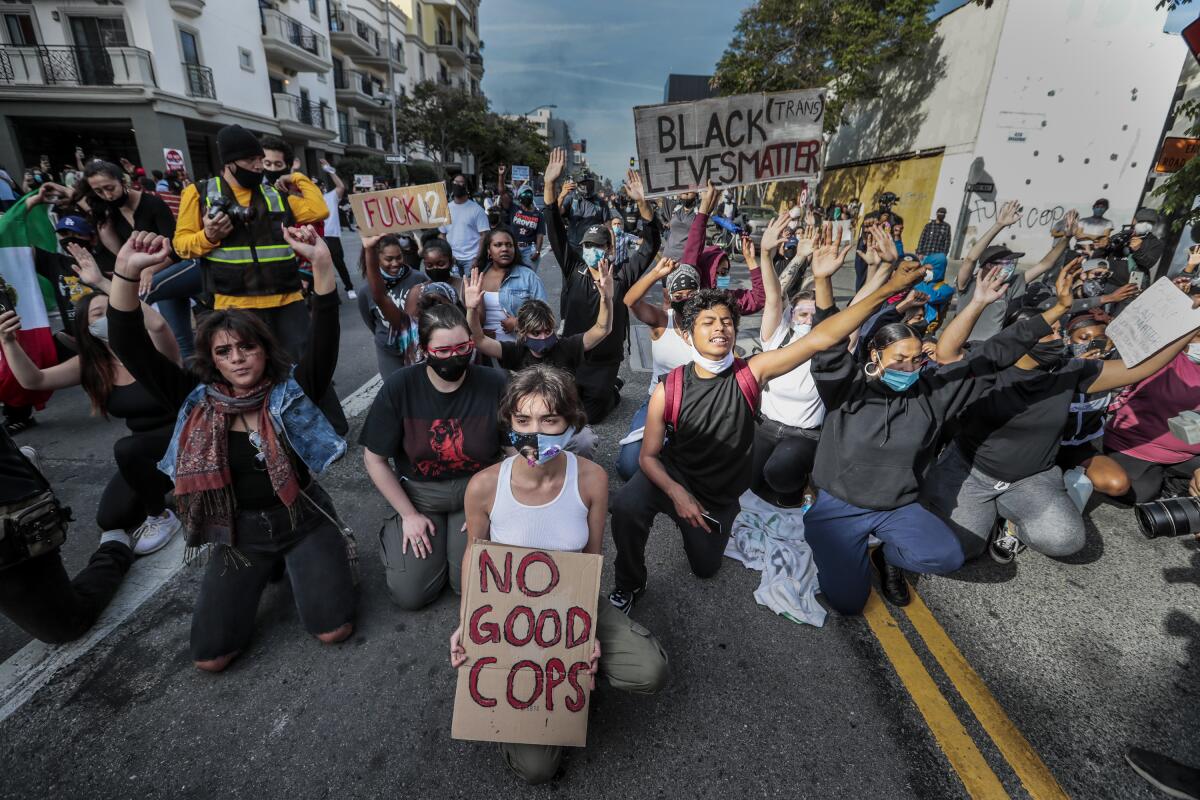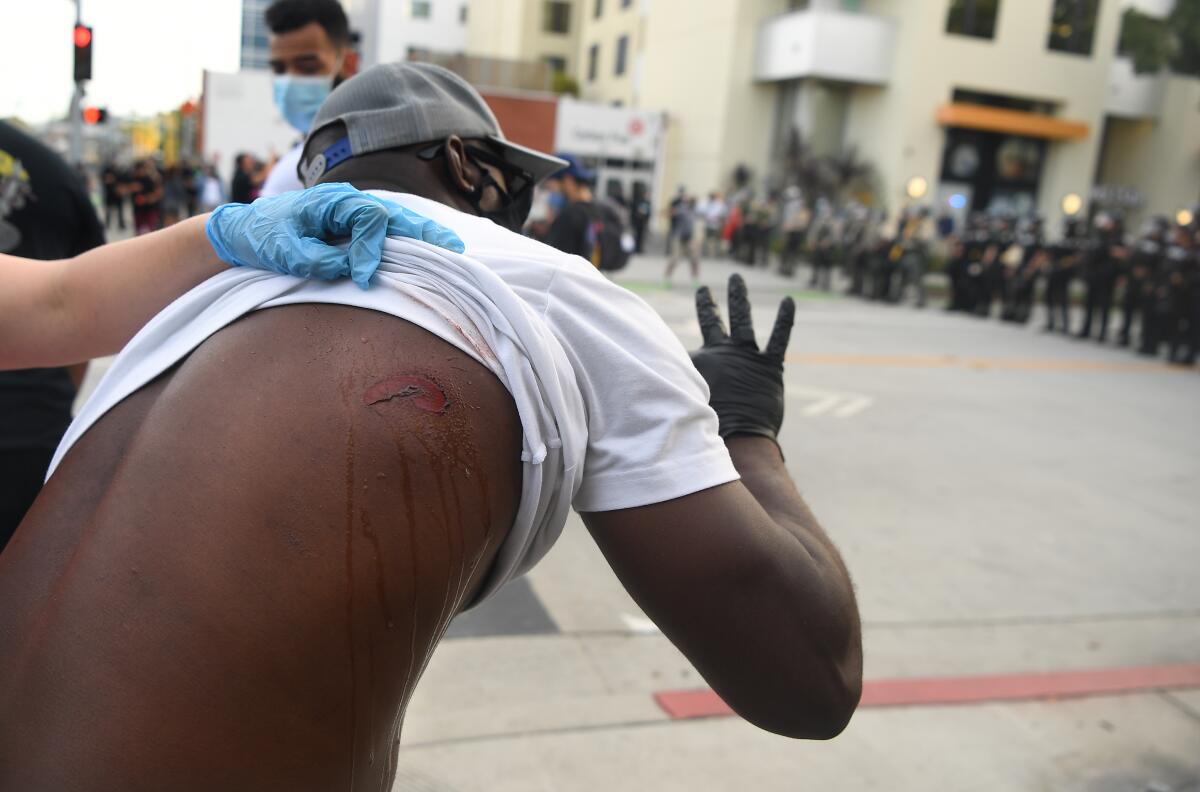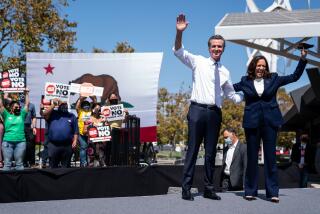Cities are being destroyed. California clearly isn’t as enlightened about race as we think

- Share via
When I opened the windows of my Westside L.A. apartment on Sunday afternoon, the last thing I expected was to get socked by the smell of whatever chemical agent had been deployed and drifted over from Santa Monica.
It seems as if all of California — long ago scarred by race riots and populated by people who pride themselves on having an evolved attitude toward race and justice — is raging or protesting.
Only a few blocks from the beach, people were busy shattering windows and looting stores in the idyllic downtown, lined with palm trees and green bike lanes. Meanwhile, a few blocks away on Ocean Avenue, the angry protesters who arrived after the peaceful protesters left were challenging police, throwing eggs and water bottles at them in the name of George Floyd, prompting the firing of rubber bullets and smoke grenades.
In Visalia, a man in a blue Jeep Wrangler sporting a “Keep America Great” flag drove through a crowd of protesters, hitting two women — a chilling reminder of what happened in Charlottesville, Va. Thankfully, the protesters suffered only minor injuries.
In Oakland, things have been out of control even for Oakland. Hundreds of protesters set fires, and many threw rocks and Molotov cocktails at police. They broke into banks and office buildings, along with small shops and restaurants, including several owned by black proprietors.
Mayor Libby Schaaf lamented that at a news conference Saturday: “This horror was visited on this same community that we are trying to lift up.”
In La Mesa, anger over the police killing of Floyd in Minneapolis mixed with anger over the arrest of a local black man, who police say assaulted an officer at the Grossmont Transit Center. A video of the man’s encounter with the white officer went viral last week and now activists want the officer to be held accountable.
“I’m so tired of seeing young black men’s lives not meaning a thing in this country,” Desmond Collins of La Mesa told the San Diego Union-Tribune on Saturday.
In Sacramento, a standoff that started at the Capitol shifted to the Main Jail, as protesters and sheriff’s deputies went at each other in brief but tense dust-ups. One protester, according to the Sacramento Bee, brought along a banner calling out local District Attorney Anne Marie Schubert, who has repeatedly declined to charge officers involved in shootings of black men, including Stephon Clark.
“D.A. Schubert, your hands are bloody too.”
Even in Chico, clear up there in the State of Jefferson, nearly 100 people were outside holding up signs on Saturday.
::

California likes to think of itself as enlightened about race.
We’re a majority minority state. A nation state. We’re proud of our diversity in all of its forms.
Sure, we’ve had riots over race and police brutality. The last one, in 1992, tore a chunk of Los Angeles apart, but we’ve learned from them. We’ve grown. Or so the story goes.
Today, we have police chiefs and district attorneys who are black, and sheriffs who are Latino.
We have a U.S. senator who is in the mix to become the first black vice president. The leader of our state Senate is a lesbian. The leader of the state Assembly is Latino. “Auntie” Maxine Waters, the unapologetically black congresswoman and original pain in Donald Trump’s you know what, is from here.
We have city councils and county boards of supervisors that overwhelmingly reflect the diversity of constituents. Politicians deliver speeches in multiple languages. Government documents are issued that way too.
We stand up for immigrants in California, a policy position adopted after the unmitigated racist disaster that was Proposition 187. We’ve sued the Trump administration dozens of times, often to ensure that people don’t have to live in the shadows because of their immigration status.
We have an enormous social safety net that has widespread support from taxpayers because we see it as our responsibility to care for the least among us, who, like everywhere else in the U.S., tend to be disproportionately black and brown.
I moved to California five years ago — first to Sacramento and then to Los Angeles — seeing these things and only these things.
Since then, I’ve learned that the reality of this state, while far, far better than the Midwestern one that I left, is complicated — especially for black people who make up a mere 6% of the population.
That these violent uprisings and peaceful protests are happening in cities large and small, up and down the state speaks to something black people know well and many others, especially self-absorbed white liberals, often choose to ignore: California is not as enlightened about race as we would like to believe.
::
Don’t think for a second that what you see in our streets is only about what happened to Floyd in Minneapolis.
These Californians are enraged about life in California, just like residents of Minnesota, Kentucky and every other state that has been blindsided by mass protests in recent days are enraged about their lives there. And their lives in this country as a whole.
It’s about police brutality, yes. It was only a few weeks ago that an LAPD officer was caught on video repeatedly punching a person of color in the head in Boyle Heights.
But that’s only part of it. What’s really manifesting itself on the streets from San Francisco to Santa Monica is the absolute, incalculable rage about the race-based inequities that have been ignored for too long by officials at all levels of California government.

The coronavirus outbreak has made this plain.
A recent Times data analysis found that black and Latino Californians who are younger than 50 are dying of COVID-19 in significantly greater numbers than white people.
In Los Angeles County alone, the death rate for black residents is double that of white residents. For Latinos, it’s 70% higher. It isn’t much better in San Francisco, where researchers tested 4,160 people for the coronavirus and found that though Latinos only made up 44% of those tested, they accounted for 95% of the positive cases.
One reason for the disparities has to do with unequal access to healthcare. But perhaps a bigger reason is that we have an economy that has long been stacked in favor of the white and wealthy.
While some of us had the privilege of being able to work from home and complain about having to be on Zoom all day, many black and brown Californians had no choice but to put themselves at higher risk of COVID-19 by ringing up groceries, driving buses and delivering Grubhub orders as “essential” workers.
Or, people like Maria Teresa Figueroa, who had little choice but to keep working in the fields of McFarland, a small city surrounded by grapevines just north of Bakersfield. She thought she had COVID-19 in January and was forced to take time off, losing wages as a result.
“We are working from sunup to sun down to put food on people’s tables,” she said.
Now Figueroa is on the verge of losing her housing because she can’t afford rent.
People of color are particularly vulnerable to the whims of the economy. Nationally, blacks and Latinos have lost jobs at higher percentages than white people because of the coronavirus. And even before the pandemic, both groups were overrepresented among California’s homeless population — the result of many factors, but namely systemic racism and abject poverty.
So as the economy tanks and the unemployment rate climbs to levels not seen since the Great Depression, we all know who will bear the brunt of it. Again. Think about that the next time you grouse about why looters descended on downtown Santa Monica and the Grove — symbols of extreme wealth in a state overrun with poverty.
At last count, there were 165 billionaires in California. There are also more than 150,000 homeless people in this state, many of whom have been living in filthy encampments for years. And now, with housing costs that have been allowed to rise largely unchecked and the added economic disruption of the coronavirus, many more, mostly black and brown Californians are on the verge of suffering the same fate.
So is it really all that surprising that some people, angry and possibly in dire economic straits themselves, don’t care about causing damage and stealing from wealthy neighborhoods?

In these dark times, what gives me hope is the same thing that pulled me to California in the first place: A willingness to recognize and figure out how to do the right thing.
That is certainly more than I can say for the red state that I left. At the time, Vice President Mike Pence was the governor of Indiana, and he had just ignited a national fervor by signing a law that allowed businesses to discriminate against the LGBT community on religious grounds.
It was about par for the course for him. He spent his entire time in office figuring out how to make it harder — or at least more traumatic — for women to get an abortion, how to tie health insurance and food stamps to work requirements, how to let more people have guns without background checks and, of course, how to prevent same-sex couples from getting married.
I had built a life for myself in the blue island of Indianapolis. Being a woman who is black, gay and liberal, I knew I had to leave.
So it meant something to me that, as news was breaking about the National Guard being deployed to L.A., Gov. Gavin Newsom tweeted: “The racial inequities that exist in our society are evident all around us. Just look at #COVID19. Communities of color are overwhelmingly impacted. We must continue to work toward a more just, equitable future.”
On Monday, Newsom, visibly shaken and humbled after the tumultuous weekend, said black people have lost patience because we have heard promise after promise for decades, but haven’t seen progress. And he’s right.
“We prune,” Newsom admitted. “We don’t tear out the institutional racism.”
His words aren’t even close to enough, I know. We need action. As Newsom acknowledged, government institutions have a responsibility to prove that “we’re capable of being more as a society.” And in the weeks and months ahead, as I travel the state to tell people’s stories, I plan to hold him and other elected officials accountable to that very thing.
For it isn’t enough to meet this moment, as Newsom is so fond of saying. We have to do something with this moment — this pandemic, this revolt, this presidential election — so we don’t return to a normal that, while aspirational, left so many Californians behind.
No justice. No peace.
More to Read
Sign up for Essential California
The most important California stories and recommendations in your inbox every morning.
You may occasionally receive promotional content from the Los Angeles Times.














